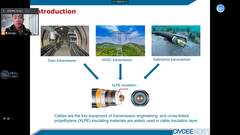Effect of antioxidant on the viscoelastic behavior of LDPE-based insulating materials used in HVDC cables
ID:196
Submission ID:250 View Protection:ATTENDEE
Updated Time:2021-12-03 10:46:37 Hits:855
Oral Presentation

Start Time:2021-12-16 10:30 (Asia/Shanghai)
Duration:15min
Session:[D] High voltage and insulation technology » [D4] Session 22
Video
No Permission
Presentation File
Tips: The file permissions under this presentation are only for participants. You have not logged in yet and cannot view it temporarily.
Abstract
It is significant to study the effect and mechanism of antioxidant on viscoelastic behavior of low-density polyethylene (LDPE) insulating materials used for high-voltage direct current (HVDC) cables. In this paper, dicumyl peroxide (DCP) and three kinds of antioxidants are respectively mixed with LDPE to prepare the cable insulating materials. The effect of antioxidant on melt viscoelastic properties of cable insulating materials are obtained by rotational rheometer testing. Moreover, the molecular models of cable insulating materials are established and the microcosmic mechanism for effect of antioxidant on its viscoelastic behavior is investigated. The experiment results show that different antioxidants have different effects on the melt viscoelastic properties of LDPE-based cable insulating materials. Besides, the molecular simulation results indicate that viscoelastic behavior of different cable insulating materials are determined by the chemical composition and topological structure of antioxidant molecules. Antioxidant molecules with the more effective polar groups and the smaller molecular weight can have greater influence on viscoelastic properties.
Keywords
High-voltage direct current cable, low-density polyethylene insulating materials, antioxidant, molecular dynamics simulation
Speaker




Comment submit